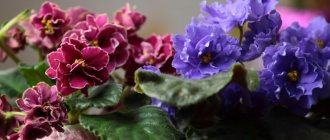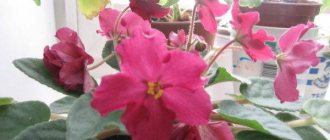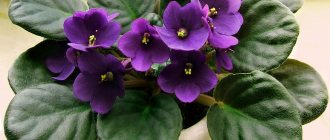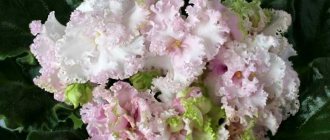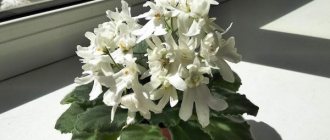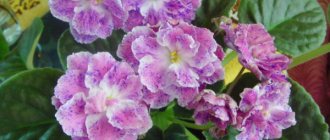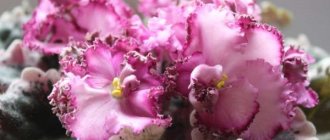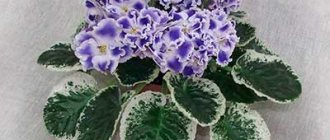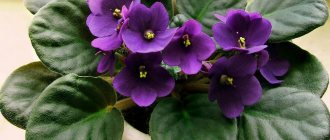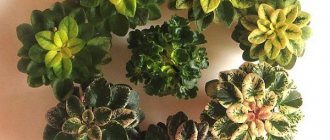Types of Saintpaulias and their care
Caring for Saintpaulia is simple, the plant forgives even one or another mistake.
Saintpaulia is one of the most popular houseplants due to its vibrant flowers and richly colored leaves. In addition to the 11 natural species in this genus, there are countless hybrids. If the Saintpaulia is well cared for and given the right conditions for the plant, it will grow and bloom all year round. In bright rooms with high humidity, these beautifully flowering plants do very well.
By now, you can choose from hundreds of varieties of Uzambara violets. These plants are especially intensively bred in the USA. In Europe and Russia their variety is not so great, but you can find about 40-60 varieties in trade. When Saintpaulias are grown in good conditions, the plants will bloom and develop throughout the year.
Violet or Saintpaulia
In the 90s of the 19th century, an ornamental plant was discovered in the Uzambara Mountains of Tanzania. Its seeds were sent to the head of the Dendrological Society of Germany. Soon the seeds were germinated by the German botanist Wendland. He also studied the plant, described it and entered it into botanical dictionaries under the name “Saintpaulia violetflower” .
The beautiful plant was presented at the pan-European flower exhibition in Ghent in 1893. The flower immediately attracted the attention of indoor plant growers, and several large flower companies fought for the right to possess and breed it. As a result, the exclusive rights to breed Saintpaulia violetflower were acquired by the E Benary flower corporation.
By the mid-20th century, violet-flowered Saintpaulia was popular on all continents and was represented by tens of thousands of hybrid varieties.
However, in everyday life you can very rarely hear the name Saintpaulia. More often, a home flower with velvet foliage is called “Violet”, “Uzambara Violet” or “Indoor Violet”.
In turn, the real Violet (Viola) is a plant from the Violet family (Violaceae), growing in northern latitudes, which can be found in forests and mountains. In culture it is used as a street and garden plant, for example such a very popular hybrid as “ pansy ”.
However, Saintpaulia violetflower and Violet are not related, they represent different genera of plants, have a different appearance from each other and require different maintenance conditions.
Saintpaulia ionantha
Saintpaulia violetflower (hybrids of S. Ionantha) grows like its herbaceous parent plant with short shoots and a flat rosette. The soft, dark green and hairy leaves are heart to oval shaped. The leaves can be up to 7 cm long and 3 cm wide. The underside of the leaves sometimes has a reddish glow. The length of the petioles is about 6 cm. Saintpaulia ionantha reaches a plant height of 5 to 10 cm and a diameter of 10 to 25 cm.
Description of Saintpaulia
Saintpaulia is loved in indoor floriculture for its small size and long (up to 10 months a year) flowering.
Saintpaulias are often low herbaceous plants with fleshy, hairy, round leaves. Leaves of green or spotted color are located on shortened stems forming a basal rosette.
The flowers have five petals, collected in racemes. Color and shape depend on the variety. Saintpaulia also has a calyx consisting of five sepals. The fruit is a capsule with numerous small seeds with a straight embryo.
The natural range of Saintpaulia is limited to the mountainous regions of Tanzania and Kenya, with the vast majority of species found only in Tanzania, in the Ulugur and Uzambara Mountains (on modern maps the name “Usambara Mountains” is usually used. Saintpaulia often grows near waterfalls, on river terraces, in water conditions dust and fog.
Saintpaulia ionantha ssp. grandifolia
S. ionantha ssp. grandifolia produces much thinner and larger leaves than most of the rosette-forming species described here.
The oval leaves have a sawtooth edge and about 10 cm long stems. One sheet up to 10 cm long and 8 cm wide.
The up to 7 cm long stems can bear up to 20 dark purple flowers. The diameter of the flowers is about 2 cm.
Saintpaulia ionantha ssp. Grotei
Saintpaulia ionantha ssp. grotei is considered the generic form of many pendulous forms of Usambara violets. The creeping, branched stems of this species grow up to 20 cm long. The almost round leaves are slightly serrated at the edges and covered with short, fluffy hairs. Petioles up to 25 cm long. Flowering shoots, about 15 cm long, form two to four flowers. Which are purple-blue around the edges and dark purple in the middle.
Pot for Saintpaulia
Since the plant’s root system is not very powerful, in a large pot the soil will remain undeveloped and may begin to sour. Therefore, the pot for Saintpaulia should be quite small and shallow. The plant needs to be replanted every two to three years; you should not rush into it - the Usambara violet feels good even in small containers, which are much smaller in width than a rosette of leaves. After transplantation, you should not water the plant for the next day or two.
Saintpaulia violet flower miniature (miniature Usambara violet)
Miniature Usambara violets are a variety of the South African species S. Ionantha. Like the original species, the miniature forms grow with a flat-appearing rosette, soft and slightly hairy leaves, ranging from oval to heart-shaped. Leaf colors vary among cultivars and range from dull green to dark green and bluish purple. The central leaf axils produce ascending flower stalks with slightly branched peduncles, each bearing 3 to 5 simple to full flowers in the colors white, pink, red, blue and purple.
Origin of the beauty
This small plant belongs to the Gesneriev family; the homeland of wild Saintpaulia is located in eastern Africa - in Kenya and Tanzania, in the Usambara (Uzambara) mountains. It was in Africa in 1892 that the German Baron Saint-Paul (or Saintpol), who was at that time the military commandant of the African colony of Germany, which occupied the lands of Rwanda, Tanzania and Burundi, saw beautiful flowers.
The baron sent the seeds of the plant to his father, who gave them to the botanist Wendland, director of the Hanover Botanical Garden. It was Hermann Wendland who grew specimens of the plant from seeds, described them as a new species of Saintpaulia violetflower, and identified them as a separate genus Saintpaulia. A year later, in 1893, Saintpaulia was presented in Ghent at the international flower exhibition, after which the Benari company acquired the right to industrially breed it. Gradually, the beauty won the sympathy of flower growers and breeders all over the world, and by 1949 more than 100 varieties of violets were already known. Today the number of varieties and hybrids is in the thousands. In some countries this plant is called "African violet".
Place for Saintpaulia, lighting for Saintpaulia
All Saintpaulias need a well-lit and very bright place. In summer, plants should not be exposed to direct sunlight, otherwise the flowers and leaves will get burned. However, diffused, indirect sunlight or lighting through tinted glass will suit her. Saintpaulia requires year-round light intensity of at least 1500 to 5000 lux.
Eastern or western flower windows are well suited for Saintpaulias. South-facing windows are also suitable places for them, but the strong sun should be greatly reduced here by curtains, sun-loving plants or the like. Trees or shrubs growing close to a south-facing window will usually serve the same function well, as long as they prevent the strong afternoon sun from shining through the window.
During the summer, adequate lighting is not a problem unless you place the plant in a dark corner of the room. During the fall and winter season, you should check the light values because Saintpaulia will quickly stagnate in areas with poor light.
In this case, you can hang lighting above the plants. Phytolamps are turned on for twelve hours a day. With sufficient lighting and good care, Saintpaulia will bloom without interruption.
Watering Saintpaulia
During the main growth phase, Saintpaulia is watered sparingly.
Moderate watering of Saintpaulia
- Before watering, let the top layer of the substrate dry to a depth of about 1 cm. Testing with your finger in this case works well (or you can buy (on Aliexpress) and use such a device - ]]>https://ali.pub/27q8r1]]>) . When the top layer of the substrate dries well, watering is carried out. Inside the pot, the soil remains evenly moist; the substrate should not dry out completely.
- When you water, you give just enough water to keep the earthen ball evenly moist, but not oversaturated with water.
- As soon as the first drops of water run out of the drainage hole, stop watering. Excess water is poured out after 20 minutes.
Since the core or leaves of Saintpaulia are not allowed to get wet, it may be easier to water the plants through a tray. To do this, you pour some water into the stand and wait until it is all absorbed. This is repeated several times depending on the size of the pot. There should be no water left in the pot stand.
It is advisable to use only warm, soft tap water or rainwater for irrigation. Usambara violet is a humus root. Lime and cold water damage plants. When watering Saintpaulia with tap water, this happens quickly, usually due to the pH value being too high (> 6.5) and/or the water hardness being too high.
If you do not have the opportunity to collect rainwater, you should use an ion exchanger (for example, you can buy one (on Aliexpress) - ]]>https://ali.pub/27srvb]]>) to soften the water for irrigation.
If the room temperature drops below 16°C for several days, you will need to limit watering until the contents of the pot are 2-3cm dry.
Features of care
Temperature: optimal temperature is between 20-22°C. Saintpaulia can tolerate short-term drops to 12°C (not lower), but cannot tolerate sudden temperature fluctuations.
Lighting: bright but diffuse lighting is necessary (grows well in artificial light).
Humidity: it is optimal to maintain moderate, but always constant humidity, which can be determined by the state of the earthen clod. It is best to water Saintpaulias through a tray with warm water so that splashes do not fall on the leaves. Spraying is not recommended (burn-like spots appear on the leaves), but increased atmospheric humidity is desirable - for this you need to spray the air half a meter from the plant and place additional sources of water nearby.
Soil: soil mixture of 2 parts coniferous soil and 1 part peat.
Nutrition: fertilizing is required if the container for Saintpaulia is too tight, but their abuse leads to a special disease in which transparent watery spots appear on the leaves. Then feeding is urgently stopped, and the damaged areas are carefully washed with a warm (about 30 ° C) weak (light pink) solution of potassium permanganate.
Reproduction: by apical stem and leaf cuttings. Leaf cuttings can initially be rooted in boiled water (before the first roots form), and continued in the above-mentioned soil mixture. They are transplanted into a regular soil mixture after the daughter rosettes begin to grow (after 2-3 weeks). Less often - by seeds (seeds are small, dusty).
Other care: do not replant frequently (no more than once every two years), as this will result in active growth to the detriment of flowering. When replanting, under no circumstances should the plant be excessively buried in the substrate: the petioles should be located just above the soil level, otherwise the plant may rot and die. It is better to handle young specimens with a lump, slightly loosening its lower part.
Air humidity
High humidity is important when caring for Uzambara violets. Therefore, place the pots in bowls filled with water on pebbles (details shown in the picture). With sufficiently high air humidity, the plants bloom well and develop well, provided that the other care needs of Saintpaulia are met at a sufficient level.
Outside the heating season, natural humidity is sufficient for most plants. However, in winter, when the heating is turned on, the humidity in our apartments drops significantly.
This is especially problematic when the plant is located near a radiator during the heating season. Using a weather station or a simple hygrometer, you can measure the moisture content in the air; if necessary, you can increase the humidity with evaporators (you can order this inexpensive hygrometer-thermometer on Ali - ]]>https://ali.pub/27tk6z]]>). Do not spray water on Saintpaulia leaves.
Wintering of Saintpaulia / Dormant period
Uzambara violets do not have a rest period and grow all year round. However, due to lower light levels and shorter days during the winter months, plant growth is significantly slower. If Saintpaulias are supported with sufficient lighting in winter (from 1500 to 5000 lux), they will grow and bloom throughout the year.
In winter, the temperature should not fall below 18°C.
To be able to correctly assess the moisture content inside the pot, a moisture meter for indoor installations is needed. This is especially true for large breeders.
We posted a link to a simple and inexpensive device above. You can also buy moisture meters at hardware and garden stores.
Diseases, problems, pests and treatment
Saintpaulia is a very sensitive plant, and if it is infected or damaged by insects, then treatment is useless. You will have to get rid of the flower.
Incorrect care, especially in terms of violating the rules of watering and humidity, leads to the death of Saintpaulia.
Uzambara violets are often affected by fungal infections - powdery mildew, rust, spotting, smut, black leg, gray rot, fusarium.
Of the infectious diseases, Saintpaulia can be destroyed by variegation, cucumber mosaic and tobacco ringspot virus.
Pests also cause plant death. Of particular danger to Saintpaulia are thrips, spider mites, strawberry nematodes, aphids, violet pearlworm, root-knot nematode, paralongidorus major and clover cutworm.
Reproduction of Saintpaulia (Uzambara violet)
Saintpaulia can be easily propagated from leaf cuttings. For this, mature and healthy leaves are taken. The petiole of the bush is cut to 2 cm and planted in a pot in a moist substrate to a depth of 12 mm to 15 mm. A mixture of peat and sand or peat-based soils are best suited for this crop.
To ensure sufficiently high humidity during root formation, cover the pot with a plastic bag. Alternatively, an openable expansion box is used directly.
To form new shoots, you need a bright but not sunny place and a temperature between 18 and 24 ° C. At this time, water very little or not at all, the substrate should not dry out and should always be slightly moist.
After 8-10 weeks, a small plant appears at the base of the petiole and appears on the surface of the earth. Over the next 2 months, the small young seedlings gradually open for longer and longer periods until they are fully adapted to the normal environment. At this time, water lightly so that the soil does not dry out. Apply commercially available liquid fertilizers in low concentrations once a week.
As soon as the plants grow from 3 to 5 cm, they are carefully separated from the old leaf, and planted separately in pots with a diameter of 5-6 cm. The plants can now be cultivated as adult specimens.
Saintpaulia cuttings can also be rooted in water. Once the roots have grown to a length of 2 to 3 cm, the plants are placed in pots with the recommended substrate.
Classification of varieties of indoor violets
There are many varieties of violets, varying in size, flower shape, number and color of petals. Moreover, the same variety can belong to several groups. Now we will try to understand the classification of indoor violets.
According to socket size
Micromini . They have a rosette diameter of up to 8 cm. Against their background, ordinary Saintpaulias with a diameter of 20-40 cm look like giants. They are grown only in compact pots with wick watering. Otherwise, the risk of them drying out is too high - if left without moisture, they dry out and die quite quickly.
Mini . The diameter of the rosette of such a violet does not exceed 12-15 cm. Just like microminis, they are grown, most often, with wick irrigation. They tolerate propagation well and therefore take root faster than larger varieties. During flowering, they form many attractive, bright and original inflorescences.
Half mini . They have a rosette diameter of up to 20 cm. Most of these varieties were bred with the participation of the domestic botanist Igor Milekhin. It is important to know that excess light is harmful for semi-mini violets! In a short time, all the foliage may turn yellow, and the rosette becomes flat in shape.
Standard - rosette 20-40 cm in diameter.
By flower size
Based on flower size, violets are divided into the following groups:
- small-flowered - up to 2 cm;
- medium-flowered - from 2 to 4 cm;
- large-flowered - from 4 to 6 cm;
- especially large-flowered - more than 6 cm.
Types by flower shape
Depending on the size and location of the petals, there are 5 types of indoor violets:
- Pansies;
- Star;
- Bell;
- Bowl;
- Wasp.
This may be interesting: Clerodendrum - home care
Let's get to know them in order.
Pansy (Pansy)
The five petals on the flower are arranged in two rows. In the top row there are two smaller petals, and in the bottom row there are three larger ones. In this group of violets we highlight the following varieties:
Lyon's Pirate's Treasure. Breeder S. Sorano.
Violet Liens Pirates Treasure has bright pink flowers with a wide crimson edging around the edge. Along the border of the main color and the border, the petals are strewn with a scattering of small dark crimson dots. The rosette consists of leaves with a bubbly texture.
Cinderella's dream
Saintpaulia Cinderella's Dream has large, semi-double, lacy flowers of light purple color with a crimson tint. Purple-violet patterns run across the petals. The top two petals are smaller and darker in color than the bottom three. Their edges are greenish and fringed. The border is corrugated. The rosette consists of dark green, evenly colored wavy leaves.
Melody Kimi. Breeder Sunnyside/Levy.
The Melody Kimi variety has a symmetrical rosette made of “quilted” wavy leaf plates. A white simple violet flower has two blue upper petals and a border of the same color on the main background.
Star
It is distinguished by the same size of all petals and their uniform arrangement around the center of the flower. In this group of violets we will introduce you to the following varieties:
Kev's Heavenly Star. Breeder K. Degner.
Kev's Heavenly Star violet has the appearance of a simple semi-double pink star with a wide dark fuchsia border.
Goddess of beauty. Breeder E. Korshunova.
The violet variety Goddess of Beauty has a large rosette of dark green leaves. The inflorescences display bright double flowers - pink stars with tints of purple-violet tones.
Magic of Love. Breeder E. Korshunova.
The magic of love . This large-flowered violet has densely double star-shaped flowers, shaped like pompoms, painted in burgundy color with a beet tint. The edges of the petals are decorated with elegant white edging. The rosette consists of beautiful green leaves.
Black Prince
Saintpaulia Black Prince has large dark red double flowers in the shape of a star. The standard-sized rosette consists of dark green foliage, red on the underside.
Rosemary. Breeder E. Lebetskaya.
Saintpaulia Rosemary has a standard rosette of dark green leaves with serrated edges. And star-shaped double flowers combine several bright touches at once. Their notched petals are gracefully ruffled, and the white background is wonderfully painted with touches of pink and splashes of blue at the same time.
Marshmallow
Zephyr has double or semi-double flowers with large, creamy-white petals, on the surface of which coral or pink strokes are scattered. The edges are wavy. Peduncles are large and erect. The large but compact rosette of this Saintpaulia variety consists of light green leaves. The plant grows quickly. It does not like high temperatures, at which it begins to bloom with simple white flowers.
Austin's Smile. (Austin's Smile). Breeder LLG / P. Sorano.
Austin's Smile has a large rosette of dark green leaves and large single star flowers of coral pink color with a dark pink eye and crimson edging.
Bell
It is distinguished by petals fused at the base. This feature prevents the flowers from opening completely, as a result of which they acquire a resemblance to bells. We will present this species with the following varieties of indoor violets:
EK-Admiral. Breeder E. Korshunova.
Violet Admiral has large cornflower blue semi-double bell flowers with wavy edges. The pointed, dark green leaves of this Saintpaulia have a creamy-purple edge.
Shining bell
The flowers of the Shining Bell bloom in the form of blue bells with wavy edges. They show rare touches of fantasy. There is a bright yellow eye in the center. A regularly shaped rosette of green leaves.
Sea wolf. Breeder E. Korshunova.
A large rosette consists of dark green fleshy leaves. The flowers are also large, up to 8 cm in diameter, blue. The corollas are semi-double, shaped like bells. The wavy petals of the Sea Wolf at the stage of full bloom are decorated with an elegant mesh pattern.
Chanson
Violets of the Chanson are unpretentious, bloom profusely and for a long time. Double flowers look like bells. They consist of a huge number of violet-purple or dark blue velvety petals, playing in the light with various shades. In addition, the wavy petals have light or dark pink spots. A large, symmetrically growing rosette consists of smooth, shiny, dark green leaves.
Rob's Dandy Lion. Breeder R. Robinson.
Saintpaulia Robs Dandy Lion has a rosette consisting of dark green leaves with slight variegation, and large bell-shaped inflorescences of a greenish-cream hue, reminiscent of snowdrops in shape.
Bowl
It differs in that the petals that are not fused at their base still do not allow the flower to fully open. The flower retains its cup shape throughout its flowering period. In this group the following varieties of indoor violets can be distinguished:
Boo Man. Breeder S. Sorano.
Boo Man (Boo Man) has double or semi-double cup-shaped flowers of a soft blue color. The upper petals are usually white, sometimes slightly greenish, up to 3 cm in diameter. The leaves are dark green, oval, spoon-shaped.
Ming Dynasty. Breeder I. Fredette.
Ming Dynasty . This Saintpaulia is distinguished by its heavily ruffled, cup-shaped, snow-white flowers with pink or lilac edges. There are double and semi-double specimens. The rosette consists of wavy variegated leaves.
This may be interesting: Diseases and pests of gloxinia - how to deal with them
Wasp
It is distinguished by completely separated petals, two of which are rolled into a tube, and three, elongated, hang down. This group includes the following varieties of indoor violets:
Lunar Lily White
Lunar Lily White variety has a small rosette of light green leaves with a “quilted” texture. Its inflorescences consist of 3 - 8 white simple and semi-double flowers about 4 cm in diameter.
PL-Zemfira. Breeder L. Beekeepers.
Zemfira has a medium rosette of green leaves, variegated in the center. Single or semi-double lilac tubular flowers have ruffled edges.
Satellite (Spootnik). Breeder J. Dates.
Saintpaulia Sputnik has a small rosette (about 15 cm) of light green leaves up to 5 cm long. The flowers of this violet are red-violet in color.
By degree of terry
Also, varieties of violets can be divided according to the degree of terryness or the number of petals. On this basis, all violets are divided into the following groups:
- Simple (5 petals).
- Comb type is a type of semi-double Saintpaulia, in which, in addition to five petals, there are 1 - 3 additional underdeveloped ones.
- Semi-double is when the peduncle has more than 5 but less than 10 petals, most often 7-8. In this case, the stamens are clearly visible.
- Terry is a type of violet in which the number of petals exceeds 10. There are so many of them that they cover the stamens.
- “Carnations” are Saintpaulias, the flowers of which are similar to double ones, but larger, with more petals on the peduncle. In appearance, such Saintpaulias really resemble carnations, hence the name.
Along the edge of the petal
The petals of Saintpaulia are wavy, notched and fringed.
By color
Indoor violets, based on the color of the petals, are divided into plain and painted in two or more colors.
Plain
This type of Saintpaulia has only one color of petals. The colors can be very different: white, yellow, orange, pink, red, blue and even green. For example, " Blue Teal Fly ".
Blue Tail Fly. Breeder J. Dates.
This violet has bright blue flowers with tubular upper petals and elongated lower petals. The rosette consists of fleecy leaves rolled into “balls”. Using this variety as an example, it becomes clear that one variety can belong to several classifications. Blue Tail Fly Applies to both “Wasp” and “Solid” violets.
Gillian. Breeder D. Ferguson.
Gillian's violet has a rosette of rounded "quilted" green leaves up to 40 cm in diameter. White large double flowers, resembling a carnation in shape.
Two-tone
These indoor violets have two shades of the same color on their petals. They can be in the form of shadows, rays or thickening of color from the center to the edge.
Marie-Sylvia. Breeder M. Tremblay
The violet variety Marie-Sylvia is characterized by simple and semi-double light lilac flowers with pronounced dark lilac tips of the petals. Moreover, on the two upper petals the darkening is stronger than on the lower ones.
Rum Punch, or Rum Punch. Breeder S. Sorano
Rum Punch is a variety of rare beauty, with characteristic large semi-double and double flowers resembling a star in shape. The edges of the petals are wavy, ash pink, and are set off by the deeper mauve lower petals.
Two-color or multi-color
These violets are distinguished by a border that contrasts with the main color.
Iceberg. Breeder S. Sorano.
This Saintpaulia variety is characterized by semi-double and double star-shaped flowers with a thin blue ruffled border. The border is always clear, as if drawn with a pencil. But Iceberg has a tendency to darken its color towards blue; over time, the flowers can become simply purple or blue.
In some cases, violets have two borders. Here are some examples of such varieties:
Looking Glass Through the Looking Glass. Breeder S. Sorano
Through the Looking Glass is a very unusual and unlike other violet. It has semi-double light pink ruffled flowers with a raspberry-fuchsia edge and a very thin white-green edge.
Limbed
Rose of Wind. Breeder E. Lebetskaya.
Compass Rose flowers resemble graceful garden roses with pale pink petals. Toward the curled fringed edges, the color thickens, and the edging becomes crimson, and, in places, green. The picture is complemented by wavy, light green rosette leaves.
Natalia's Extravagante. Breeder N. Pineault.
Natalis Estravagante has lacy flowers of white and pink color with a border, the tone of which can be pink, green or chocolate. The rosette consists of green leaves with pink and white streaks along the edges.
Beautiful Creole. Breeder E. Lebetskaya.
A very unusual plant, prolific and unpretentious. The small compact rosette of the Beautiful Creole is strewn with many simple but very effective dark blue velvety flowers - stars, the edges of the petals are outlined with a contrasting white edging. The diameter of the flower reaches 5 cm. The strong stem is burgundy in color.
Macho. Breeder E. Lebetskaya.
This is a large-flowered variety of standard sizes, delighting gardeners with a lush cap of large semi-double flowers. The corollas of the Macho violet have a pronounced star shape and are colored in a thick burgundy-violet color. The wavy edge of the petals is set off by a contrasting white border. The rosette consists of simple oval-shaped green leaves.
Modern Talking. Breeder E.A. Arkhipov.
Modern Talking - Violet with white semi-double frilly pansy flowers edged in pink-blue-violet. The rosette consists of light green flat leaves.
This may be interesting: Diseases and pests of Impatiens
Finger color
These varieties of violets look as if they dipped their finger in paint and stained the flowers with it. Such “prints” are most often located in the middle of the petal, but can also be located closer to the edge.
Crimson Ice or Raspberry Ice. Breeder P. Sorano
Crimson Ice or Raspberry Ice has simple white pansy-type flowers with crimson-red spots on the petals that are brighter and more saturated on the lower three leaves.
Also, violets can have random strokes and spots on their petals. It looks as if the edge of the flower was dipped in paint. Moreover, on the same bush, some flowers may have such spots, while others remain monochromatic.
Southern Springtime (Mac's Southern Springtime) or Southern Spring. Breeder G. McDonald
For example, Southern Spring . This semi-miniature violet bears single to semi-double, wavy, cup-shaped flowers of white with contrasting random patches of light to almost black red. At the same time, each flower is unique and has its own pattern.
Peephole
The so-called eye looks like a round spot in the center of the flower. It can either match the main color or contrast with it.
EK-8 March
EK-8 March has huge single and semi-double white star-shaped flowers with a wavy-fringed edge and a raspberry-pink center.
Mesh
This is a pattern consisting of veins, similar to a mesh. Examples of this color can be found in other flowers, for example, in streptocarpus, but for violets it is quite rare.
Feather or Feather. Breeder I. Fredette.
The feather is a medium-sized pansy-type Saintpaulia. It has white flowers with corrugated edges and a blue pattern over the entire surface of the petal, more like lace.
Granger's Carnival. Breeder J. Eyedom.
The Granger's Carnival variety is characterized by simple flowers with a blue-violet mesh pattern. The edges of the petals are white with a clear venous pattern.
Chimera violets
They may have stripes of different colors, diverging from the center of the petal to its edges. Here are some typical varieties.
Chain Reaction. Breeder S. Sorano.
Chain Reaction is distinguished by the fact that a light lilac stripe runs down the center of the pink petals of its flowers. Lilac inclusions are scattered over the entire surface of the petals. The rosette is standard and consists of green leaves.
Queen Sabrina. Breeder P. Sorano.
Saintpaulia Queen Sabrina has double, coral-colored flowers with purple stripes on each petal. The rosette consists of small dark green leaves.
Here are photos of several more varieties of chimera violets:
Humako Sharon
Lyon's Fortuner Teller
Yukako
Fantasy
Chimpansy. Breeder E. Fisher.
Chimpansi is a beautiful variety. It is distinguished by a small green rosette composed of slightly jagged green leaves. Semi-double pink star flowers have a white wavy border along the edge. Violet petals are strewn with streaks and swirls of bright blue.
Live wire. Breeder P. Sorano.
This showy violet has huge coral pink flowers in the shape of single or semi-double stars. And, in addition, its petals are abundantly covered with blue or purple spots. Sometimes, as a result of mutation, flower growers based on Live wire obtain varieties of violets with multi-colored corollas. At the same time, the size and simple shape of the leaves remain unchanged.
Ampelous
We can also distinguish a group of currently very fashionable hanging varieties of indoor violets, which have a long stem (up to 50 cm) with several growth points. These Saintpaulias are distinguished by their lush flowering. Their stems are quite flexible, so you can try to create a variety of compositions from them. The characteristic color of the leaves is variegated. The flowers are miniature but attractive. Let us introduce you to some varieties of ampelous violets:
Ramblin' Dots. Breeder S. Sorano.
Ramblin Dots is a beautiful variety of indoor violet. The rosette consists of light green leaves with golden-white streaks. Its double star flowers are light lavender in color and decorated with a mesmerizing light purple fantasy pattern.
Falling Snow. Breeder P. Tracey.
Folin snow is a violet with light green, slightly pointed leaves. It has numerous small snow-white wasp flowers.
Variegated
Violets from the variegated group have elegant, brightly colored foliage with many different shades and contrasting spots throughout the green field. They can have yellow or white edges, a lavender or pink border at the same time. These violets have large double flowers with petals of various colors, often with a prominent border along the edge.
Pauline Viardot
This violet has a compact variegated rosette, very elegant due to the light border along the edge of the leaves. Its large, single or semi-double flowers have wine-colored petals. The edges of the petals are decorated with a thin white ruffle. Pauline Viardot's flowers grow vertically.
Soil/substrate
The substrate with slightly acidic soils, pH from 5.5 to 6.5, is ideal for growing Saintpaulia. If the pH value is not the same, the plant will not develop healthy.
Saintpaulia is planted in peat or humus substrate with the addition of soil. In addition, quartz sand and perlite are added.
If you want to plant Saintpaulia in a well-balanced substrate, mix it yourself. It's not difficult to do this. The reward is a consistently healthy and vigorous plant that is resistant to disease and pests, as long as the other care requirements of light, water, temperature and nutrients are met. Since its own substrate, unlike simple soil, does not collapse or compact over a long period of time, annual replanting can be dispensed with.
Substrate mixture for Saintpaulia
- 5 parts peat or humus substrate
- 2 to 3 parts arable soil containing clay
- 0.5 parts quartz sand
- 1 part pumice, lavalite or lava granules
Mix everything well.
The acidity of the mixture for planting Uzambara violets from 5.5 to 6.5 is adjusted by adding more or less soil. Important for this is the mixing ratio of the soil with acidic peat or humus substrate (pay attention to the pH value of the package). Everything should be well mixed. Using a device or indicator strips, you can determine the pH value of the prepared mixture and, if necessary, correct it.
Violet propagation methods
Seeds
Saintpaulia varietal seeds can be found in flower shops, or you can get them yourself - through artificial pollination, you can get a fruit in the form of a seed capsule. Before planting, the seeds are mixed with river sand and the resulting mixture is planted in previously prepared soil.
The soil for sowing is a mixture of leaf soil, charcoal, sand and vermiculite. The container is covered with film or glass and placed in a warm and very bright place. The greenhouse needs to be ventilated daily and the soil moistened. Shoots appear on the 20th day after sowing. You can pick and transplant the sprouts into separate pots after several leaves appear.
Leaf cuttings
As planting material, a strong, healthy leaf no more than four centimeters long is selected from the middle of the flower rosette. The rooting site is cut at an angle of 45 degrees.
You can germinate roots on cuttings in a glass of water, wet sand, or directly in Saintpaulia soil. When grown in bulk mixtures, the cuttings are placed under a film. Rooted cuttings are picked up and planted in stationary pots with standard soil.
Peduncles
To maximize the preservation of varietal properties, a peduncle is used for propagation. It is cut so that the stipules are several centimeters below the rooting site.
Place in a container with water. The peduncle will give roots in about three weeks, after which it can be planted in a pot.
Transplanting Saintpaulia
Saintpaulias feel most comfortable in relatively small pots. Rosette-forming species are best kept in flat pots or bowls that are one-third the diameter of the rosette. For a plant with a diameter of 15 cm, it is used in a corresponding pot with a diameter of 5 to 7 cm. The maximum size is 15 cm shells or pots.
Miniature forms and young specimens of hanging Usambara violets can also be planted in small pots or bowls. Large trailing plants, however, will do best in planting containers that provide plenty of room for roots to develop.
If necessary, Saintpaulia can be replanted at any time of the year, provided that the room temperature is constantly above 16 ° C.
Saintpaulia is transplanted when
- the pot becomes too small for the plant
- donkey substrate
- the pot is overflowing with roots
- abundant roots come to the surface
When replanting, it is recommended to remove the outer leaves as they are fragile and easily damaged. The stem of the sheets does not need to be cut, they should be torn off with one powerful jerk to the side. In this case, the entire petiole must be torn off, because the remains of the stem quickly rot and infect the entire plant.
When replanting Uzambara violet, the old soil from the roots is shaken, and all the dead roots of the plant are cut off. Even living roots can be pruned if necessary.
After transplanting, the plants should be protected from direct sunlight for 2 to 3 weeks. A well-transplanted plant recovers quickly and will continue to grow in the near future.
Community of little green men
Saintpaulia Saintpaulia, Usambara violet. An evergreen herbaceous plant with almost no stem or short stem with leaves on long petioles, collected in a rosette and flowers of various colors, arranged in several pieces on short peduncles.
Etymology of the name
The genus is named after the Saint-Paul father and son who first discovered this plant. The name "Usambara violet" is given in honor of the district in East Africa where Saintpaulia ionantha was first discovered in 1892. However, the adjective “Usambara” more correctly sounds like “Usambara”: this is the name of the mountains in Africa, where its homeland is located.
Types and varieties of Saintpaulia
The original forms are native to East Africa.
The most common cultivated species is Saintpaulia ionantha, which gives rise to numerous garden forms. In indoor floriculture, hybrid varieties bred on its basis have become widespread. Recommended Saintpaulia varieties
Saintpaulia ionantha
The leaves are oval or broadly oval, up to 8 cm long, often wavy along the edge, on long petioles. The matte surface is dark green on top and pinkish-red on the bottom. Special mini-varieties with small leaves and flowers have been bred.
Saintpaulias are divided according to four main characteristics:
1) color of flowers,
2) type of leaves,
3) type of flowers,
4) plant size.
In the first group, there are 9 colors of violet flowers:
B - blue, blue (Blue),
C - multi-colored (Multicolor),
P - hot pink or dark pink (Pink or Rose),
O - orchid, pink-lilac, lavender, i.e. pale lilac (Orchid, Mauve, Levender),
R - red, borage-chestnut, plum or the color of Burgundy wine, wine (Red, Maraon, Plum, Burgundy),
V - violet or purple (Violet or Purple),
W - white, creamy or browned, i.e. slightly pink (White, Creamy or Blush),
X - two-color (Bicolor),
Y - yellow, essentially white with a yellowish tint (Yellow).
Saintpaulia variety Wedding bouquet
In the second group of characteristics, 9 types of leaves are also distinguished:
1 - long-leaved or arachnid (Longifolia or Spider),
2 - ordinary, flat simple (Plain),
3 - quilted (Quilted), the veins of this type of leaves are so deep that it gives the impression of a quilted surface,
4 - Girl, Semi-Girl type (the shape of the leaves of one of the first varieties with this name) - obverse-oval, somewhat folded along the midrib, in the form of a scoop,
5 - corrugated, fringed, wavy, notched or combed (Ruffled, Fringed, Wavy, Fluted or Scaloped),
6 - type Supreme Amazonor Du Pont - large, like the varieties with these names (the Du-Pont group is represented by polyploid plants, named after the name of the author who received them. They are characterized by large, fleshy (leaves of light green color, densely covered with hairs and have blue, lilac-pink or lilac flowers),
7 - multi-colored, variegated (Variegated),
8 - spoon-shaped, oval, cup-shaped (Spooned, Ovate, Cupped),
9 - pointed, pointed (Pointed).
In the third group of characteristics, flowers are distinguished:
s - simple (single) (Single),
d - terry and semi-double (Double or Semidouble),
c - star-shaped,
f - corrugated or fringed (Fringed or Ruffled).
The fourth group of characteristics consists of plants that differ in size:
M - miniature or almost miniature (Miniature or Semiminiature),
S - medium, standard size (Standardsize),
L - very large (Very Large).
The variety name is formed as follows:
V. 6.3.SL—violet, Amazonian, quilted, single flowers, very large—corresponds to the variety 'Ace of Cedar Rapids', N 834—1956, SA Nemec (originator).
There are also ampelous Saintpaulias with creeping stems hanging over the edges of the pot. The flowers of the plant can be painted in various shades of white, pink, lilac, blue, blue, violet, green, lemon tones, except yellow. Collectors also distinguish 23 types of flower structure and 19 types of leaves, which, in combination with various color options, give countless variations of varietal characteristics.
Saintpaulia chimeras
What makes this group of Saintpaulias stand out from others is the extraordinary popularity of such varieties. Difficulties with reproduction only encourage collectors who want to get their hands on rare violets. In Greek mythology, a chimera was a fantastic monster with the head of a lion, the body of a goat and the tail of a dragon. Later, the word "chimera" acquired a figurative meaning - "bizarre fantasy." Such are these violets - the embodiment of the most amazing fantasies of breeders.
From a biological point of view, chimeras are a mixture of cells or tissues of different genetic structures in the same organ. A cross section of a leaf or stem of a Saintpaulia chimera shows that it consists of two genetically different layers of cells: one layer determines the main background color of the flower, and the second determines the color of the stripe. These flowers are not only beautiful in appearance, but also amazing in their essence!
The first chimeras appeared as a result of partial mutation: some cells inherited the characteristics of the mother plant, while other cells of the same plant became completely different (mutated). The color of Saintpaulia chimeras can be varied: there are two- and three-color varieties. As a rule, the main color of the petal contrasts with a stripe of another color; in addition, along the edge of the petal there is a very effective coating in the form of strokes or dots - fantasy.
Popular commercial varieties of chimeras include the following:
'Tineke' - simple pink flowers with a blue stripe,
'Mandy' - white star-shaped flowers with a blue stripe,
'Monique' - classic white with blue stripe,
'Amanda' - pink star-shaped flowers with a crimson stripe,
'Myrte' has fringed white flowers with a crimson stripe.
Caring for Saintpaulia
From spring to autumn, bright diffused lighting is required, in winter - direct sunlight. North, east, west windows with winter temperatures of +17...+20°C are suitable. Saintpaulias prefer damp areas, such as kitchens. Watering is moderate, but regular, without stagnation of water. A slight drying is tolerated by the plant, but the leaves do not restore their normal position after wilting, and the plant acquires its previous appearance only after new ones grow. Therefore, it is advisable that the soil in the container is constantly slightly moist, but not soggy.
It is recommended to water under a rosette of leaves or in a tray without moistening the leaf blades, otherwise dark spots will appear on them. In winter, during a period of relative rest, watering is reduced. You cannot spray. When keeping plants on windows, you can occasionally humidify the air above the plants and curtains from a fine sprayer, directing it upward.
Feeding is done every two weeks in the warm season. Replanted at the end of April - beginning of May annually. For planting, use a soil mixture of leaf soil, turf soil, peat, compost, sand (2:1:3:1:1), preferably adding 1 tbsp. spoons of ash per 1 liter of soil mixture. Old plants begin to form a stem at the bottom, taking on an unkempt appearance. It is recommended to rejuvenate such specimens by cutting off the top of the rosette and rooting it in water.
Sometimes it is more convenient to remove old leaves at the bottom of the bush when replanting and plant the plant deeper, burying the bare stem, from which new roots will soon form. In dry air it can be affected by aphids and scale insects. Powdery mildew, gray rot and root rot are also possible.
The causes of problems with violet flowering almost always lie in failure to provide proper care and, as a rule, boil down to the following:
• excess nitrogen in the soil;
• low humidity (less than 30%);
• lack of light (in the autumn-winter period, violets need additional lighting);
• high room temperature (more than + 26 °C);
• the substrate has an alkaline reaction;
• the pot is too large (more than 12 cm);
• long absence of transplantation.
Saintpaulia LE-Spicy Balm
Propagation of Saintpaulia
Depending on the variety, propagation of Saintpaulia has its own characteristics.
Plants are propagated by seeds solely for the purpose of obtaining new varieties; the use of this method in amateur floriculture is not recommended.
Most varietal forms are successfully propagated by leaf cuttings. The leaf is broken off or cut off in the middle part of the rosette, rooted in ordinary water or sphagnum, and, when roots appear, planted in a pot (a mixture of leaf soil and sand in equal proportions), first tied to a peg. From the base of the leaf, from 1 to 10 or more rosettes develop (usually 2–3). When the rosettes have 3-4 leaves, they are carefully dug out and separated, placing each in a separate pot.
When growing single-color varieties, it is enough to transplant one of the strongest rosettes to a permanent place; for bicolor Saintpaulias, it is necessary to grow and bring to flowering all the rosettes, since perhaps not every plant will exactly repeat the maternal characteristics. Young plants bloom within six months.
Saintpaulia variety RS-Mavka
Saintpaulias, which have longitudinal stripes of a different color on the petals, the so-called chimera varieties, are propagated by rooting peduncles. Leaf cuttings of such Saintpaulias usually produce plants with monochromatic flowers, devoid of a spectacular pattern. Peduncles are rooted in a mixture of peat and sand (1:1) with high air humidity and regular ventilation. The process takes a long time and is not always successful, so it is better for novice gardeners to purchase spectacular striped “chimeras” in the store already in bloom.
Purchasing violets
Saintpaulias get to gardeners in various ways: you can simply buy violets in a store or garden center, or purchase planting material from collectors. As a rule, only German and Dutch market varieties are presented in stores. They are unpretentious and therefore better suited for beginning flower growers, but most often their flowers do not sparkle with originality and sophistication, unlike collection varieties.
There is a great way to replenish your collection of violets and acquire really interesting varieties - to visit the Saintpaulia exhibition and sale. There you can see new products, compare old and new varieties, and choose those that you like.
For residents of remote areas who find it difficult to get to a major exhibition and sale, there is a mailing list for companies and Saintpaulia lovers. However, this method of purchasing has its drawbacks: to some extent, you are buying a “pig in a poke”, and you also pay for postage. After all, there is the possibility of death of planting material during shipment, and some likelihood of confusion with varieties. In addition, the description of a plant in the catalog does not always correspond to its real appearance.
Saintpaulia variety Frozen in Time (Sorano)
Purchasing violets from collectors is a great option because you can evaluate the plant directly and be sure that you got the exact Saintpaulia you wanted. In addition, you are given the opportunity to see with your own eyes how violets are properly kept, and receive competent advice on care from a person who “ate the dog” in this matter.
Saintpaulia RS-Green Moss
Before purchasing both adult plants and planting material, you need to evaluate their quality. Several recommendations can be given in this regard:
• Inspect the plant: in a healthy specimen, all parts are developed proportionally, leaves and flowers should not be limp, dull or pale.
• Pay attention to young leaves and the undersides of larger leaves: this is where pests are most likely to be found.
• If a plant is sold in a store in a cellophane “sleeve,” be sure to remove it before purchasing. If you are not allowed to do this, it is better to refuse the purchase: in this way, sick or damaged plants are most often hidden.
Having delivered the purchased plant home, even if you are completely sure that it is healthy, be sure to place it in “quarantine” for a week to protect the rest of the plants from possible infection.
Historical facts about Uzambara violets
The Saintpaulia violet plant was first discovered in 1892 by Baron Walter Saint-Paul, the military commandant of the Usambara district. Saint-Paul wrote very enthusiastically about this event: “The flower grew in a crevice right on a mossy stone. It seemed to glow with a pale blue light in a bowl of ten dark, richly colored leaves, and in the middle of it burned a bright yellow light. The shape and color of the petals resembled our violet, but was much more delicate.” Walter Saint-Paul sent the seeds he collected to his father Ulrich von Saint-Paul, the president of the German Dendrological Society in Fischbach in Silesia, who in turn sent them to Hermann Wendland, head of the Botanical Garden in Gerenhausen near Hannover.
Saintpaulia RS-Alenushka
Wendland sowed the resulting seeds, and in 1893 the plants bloomed. Wendland described them as a new genus of the Gesneriaceae family. Wendland named the new plant “Usambara violet.” Wendland formulated the Latin name in honor of the father and son of Saint-Paul, hence the Latin name of the genus - Saintpaulia, and in the Latin spelling of the species the name of Wendland is abbreviated at the end.
Saintpaulia was first shown at the international flower exhibition in Ghent (1893), where it aroused great interest. After the exhibition, the right to commercially propagate Saintpaulias was acquired by the Erfurt horticultural company of Ernst Benary. Soon descriptions of this plant were repeated in Italy, Belgium and England.
Since the introduction of the first Saintpaulias into culture in Europe and England, a significant number of garden variations have been obtained. In 1927, Saintpaulias were brought from Germany to the USA, where they gained enormous popularity. In the USA in 1936 there were 10 garden variations of Saintpaulia, in 1949 there were already more than 100, and currently their number has exceeded several thousand. In the late 40s, the African Violet Society of America was organized. The society has a Nomenclature Committee that registers new varieties of African violets in accordance with the system of characteristics it has developed.
Saintpaulia RS-Sirena
Saintpaulia selection
Anyone who has ever become interested in growing Saintpaulias will sooner or later try to grow their favorite flowers from seeds. Sometimes this hobby develops into a real passion, and the florist becomes a breeder. The goal of selection is to obtain plants with certain characteristics. This is a real art and a very exciting activity. Thousands of people are engaged in the selection of Saintpaulias these days.
Each new variety is not just an unusual, beautiful flower, but also a piece of the soul of the person who spent a lot of effort to obtain it. It is no coincidence that after the name of the variety the surname of the breeder is usually indicated.
Among Russian breeders I would like to mention Konstantin Lvovich Morev, Elena Vasilievna Korshunova, Natalya Aleksandrovna Puminova, Svetlana Nikolaevna Repkina, who gave us many amazing varieties of violets. It is impossible not to mention one of the first domestic breeders, Boris Mikhailovich Makuni, whose varieties still delight violet collectors.
Siren Frosen in Time (Sorano)
Ecology of home
Violets not only serve to decorate interiors, but also emit volatile phytoncides that “clean” the air. Inhaling the volatile substances of these plants has a beneficial effect on the psyche, normalizes heart rate, improves metabolic processes, strengthens the body's defenses, normalizes the processes of excitation and inhibition in the cerebral cortex, increases performance and endurance to physical activity.
Energy of violets
Violets in general and Uzumbara violet in particular have a calming effect on the atmosphere of the home. Violets create an aura of peace and bliss. The energy of violets attracts the energy of light and purity from space. It’s always easier to breathe around them, and the vibrations are no longer chaotic. Violets with white flowers are good for any apartment, but especially for those where children live. White color has always been a symbol of innocence and purity. White violets maintain a clean atmosphere in the house; they cleanse the space from vibrations of heavy thoughts and bad feelings. Violets with pink and red flowers clear the space of closed energy.
Pests, care mistakes and tips
Sometimes yellow rings or spots form on the leaves of Saintpaulia. The cause of this chlorophyll damage can be of various natures. Thus, damage can occur when the leaves are exposed to direct sunlight. The water may also be too cold for irrigation. Therefore, you should always ensure that you only water with water at the right temperature. Room temperature water is the best option for watering. Water that is too warm is usually just as unprofitable for irrigation as water that is too cold.
You can buy Saintpaulia on the Aliexpress website, following the link: ]]>https://ali.pub/281woi]]>
Thank you for reading my article, if you are interested in indoor violets, please comment on my material. See you on the pages of the Russian Summer Resident portal!
